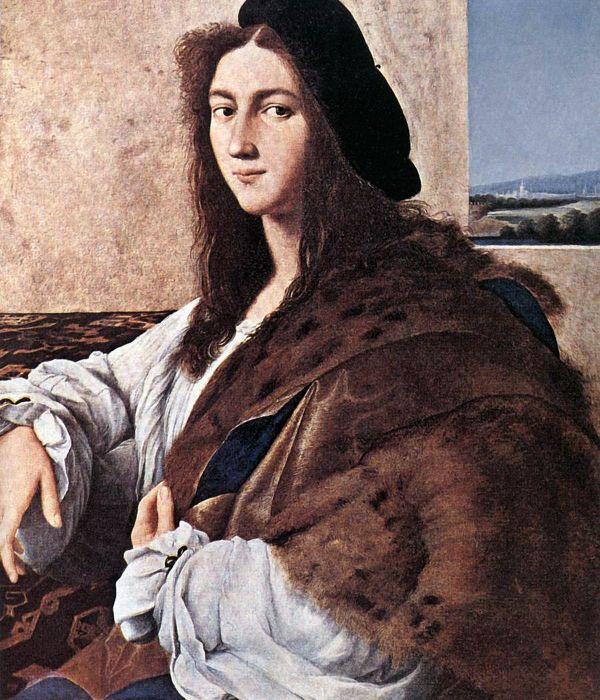Today's Birthday
Raphael SantiPronunciation: [räf"fäel´lO sän´tE, sän´tsyO]
Ital. Raffaello Santi or Raffaello Sanzio 1483–1520, major Italian Renaissance painter, born in Urbino.
In Raphael's work is the clearest expression of the exquisite harmony and balance of High Renaissance composition.
Early Training, Influence, and Work
Raphael's father, Giovanni Santi, painter at the court of Federigo Montefeltro, Duke of Urbino, first taught him the elements of art. About six years after the death of his father (1494) he entered the workshop of Perugino, whose influence is seen in The Crucifixion and The Knight's Dream (both: National Gall., London); Coronation of the Virgin (Vatican); The Three Graces (Chantilly); and the Sposalizio (Brera, Milan). The Colonna altarpiece, representing the Madonna and Saints (Metropolitan Mus.), marks the end of the Perugian period of his work.
The five predella scenes, Agony in the Garden (Metropolitan Mus.), St. Anthony of Padua and St. Francis (both: Dulwich), Procession to Calvary (National Gall., London), and Pietà (Gardner Mus., Boston), give evidence of the new influences of Leonardo, Michelangelo, Masaccio, and, especially, Fra Bartolomeo. Studying the intricacies of anatomy, perspective, and coloring, he achieved a freer, more able, and deeper interpretation than was seen in his earlier work. In Florence (1504–8) he produced numerous Madonnas that are renowned for their sweetness of expression. His self-portrait (Uffizi) and the penetrating portraits of Angelo and Maddalena Doni (Pitti Palace) are also from this period.
Mature Work
At Rome his style matured, benefiting from Michelangelo's influence. In the Vatican, Raphael was wholly responsible for the Stanza della Segnatura (finished 1511); the two largest walls represent, respectively, the School of Athens, portraying the Greek philosophers, and the Triumph of Religion, also called Disputà. On the vault are The Flaying of Marsyas and The Temptation of Eve. The ceiling is devoted to the allegorical figures Law, Philosophy, Poetry, and Theology. Two large lunettes over the windows represent Parnassus and Jurisprudence.
In the Stanza d'Eliodoro Raphael painted (1511–14) The Expulsion of Heliodorus from the Temple, The Miracle of Bolsena, The Repulse of Attila from Rome by Leo I, and The Deliverance of St. Peter. He also designed the Incendio del Borgo and painted part of it. Other designs for the Vatican include The Battle of Ostia, The Oath of Leo III before Charlemagne, and The Victory of Constantine over Maxentius; the 52 religious subjects covering one ceiling and known as “Raphael's Bible” were executed by his pupils after his design.
Among the other paintings of his Roman period are the Madonna with the Fish (Prado); Madonna of the Chair (Pitti Palace); the Sistine Madonna (Dresden); Galatea (Farnesina); the Alba Madonna (National Gall. of Art, Washington, D.C.); and the unfinished Transfiguration, completed by Giulio Romano. Portraits of that period include Julius II, long his patron; Baldassare Castiglione (Louvre); Tommaso Inghirami (Gardner Mus., Boston); and Pope Leo X with Two Cardinals.
Other Works and Accomplishments
Having been named (1514) successor to Bramante as chief architect of the Vatican, Raphael also designed a number of churches, palaces, and mansions. For his patron, Leo X, he undertook (1518) a survey of ancient Rome showing the chief monuments. He also designed ten tapestries with themes from the Acts of the Apostles for the Sistine Chapel; seven of the designs are in the Victoria and Albert Museum. Raphael was deeply indebted to the sculpture of antiquity for his mythological and biblical figures, and in his interpretation of classical art he achieved a harmony and monumentality emulated far into the 19th century.
Bibliography:
See his complete paintings, introd. by Richard Cocke (1966); complete works by Mario Salmi et al. (1969); biography by Luciano Berti (tr. 1961); studies by A. P. Oppé (rev. ed. 1970), John Pope-Hennessy (1970), and Luitpold Dussler (tr. 1971).
Who2. Copyright © 1998-2006 by Who2?, LLC. All rights reserved.
Also Born on April 06
- James Millphilosopher, economist, and historian (1773)
- Anthony Fokkeraircraft manufacturer (1890)
- Andre Previnconductor, composer, and pianist (1929)
Who Shares Your Birthday?
The Day You Were Born
The Year You Were Born











